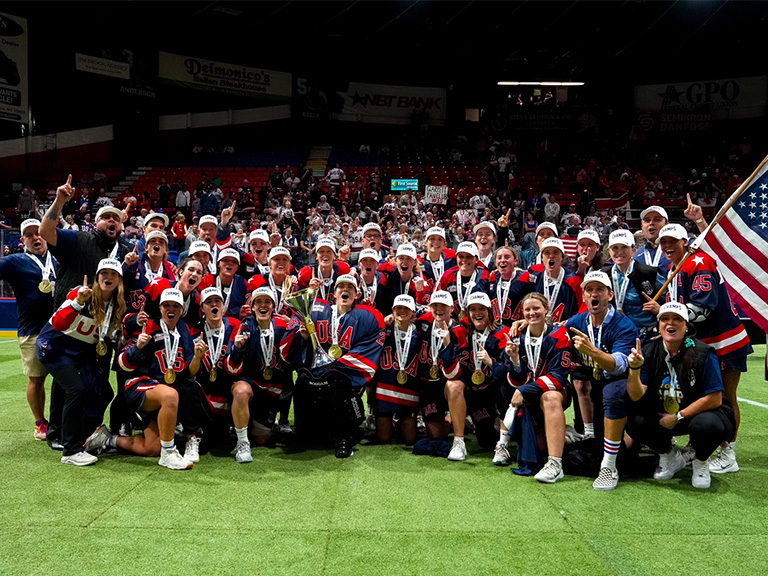When the USA women’s box lacrosse team triumphed over Canada to win gold at the inaugural World Lacrosse Women’s Box Championship in September, Ryan Wheeler ’01 was cheering the players on — while also helping guide them to victory.
 Wheeler, an assistant coach for the history-making team, has remained active in the world of lacrosse since his days as a standout on the men’s lacrosse team at Manhattan University. He spent several years with Major League Lacrosse (he was the first Jasper to play professional lacrosse) and represented the United States on the men’s national indoor lacrosse team that earned a bronze medal in 2007. Wheeler also made a point of nurturing up-and-coming lacrosse talent by leading clinics, camps and instructional sessions for both field lacrosse and box lacrosse.
Wheeler, an assistant coach for the history-making team, has remained active in the world of lacrosse since his days as a standout on the men’s lacrosse team at Manhattan University. He spent several years with Major League Lacrosse (he was the first Jasper to play professional lacrosse) and represented the United States on the men’s national indoor lacrosse team that earned a bronze medal in 2007. Wheeler also made a point of nurturing up-and-coming lacrosse talent by leading clinics, camps and instructional sessions for both field lacrosse and box lacrosse.
“One of my initial forays into coaching was in 2018 with the men’s U20 indoor team,” he says. “The world cup was held in Saskatchewan, Canada, and we coached them to a bronze medal.”
Indoor, or “box,” lacrosse is the official summer sport of Canada. It’s typically played on an iceless hockey rink with a concrete or artificial turf surface. The women’s game is just like the men’s, with the same equipment, padding and sticks. Unlike women’s field lacrosse, contact in women’s box lacrosse is permitted.
The world championships had never featured a women’s team, but that all changed when USA Lacrosse announced that it would host a women’s box tournament in 2024. “USA Lacrosse is excited about the opportunity ahead to identify and cultivate the pioneers who will help blaze new trails,” their statement read.
Around that time, Wheeler received a phone call from the head coach of the inaugural women’s box lacrosse team inviting him to join the staff, and, he says, “I happily did so.”
He and his fellow coaches then had to build a team, drawing players from the highest levels of field lacrosse. The process took about two and a half years.
“From a coaching perspective,” he says, “the ultimate challenge was taking these women who had never played this version of the game and turning them into world-championship-caliber players of the box discipline, all in a very condensed time period.”
The players had not used a men’s stick before, and only one had played a contact sport previously. “So not only was it teaching them the new discipline,” Wheeler says, “but getting them used to the rigors of playing a full-contact sport was probably one of our most prominent challenges.”
One strategy the coaches employed was to have the team scrimmage against men’s teams. “We sought out semi-professional, professional and club teams throughout North America to pit our women against over the course of the cycle ramping up to the world championships to ‘battle harden’ them to the physical nature of the indoor game,” Wheeler explains. “It helped them understand its rigors.”
The world championships were held in Utica, New York, from September 20-29, with 10 nations competing, split into two pools of five.
“Canada were the favorites as a result of their women playing box lacrosse from childhood,” Wheeler says. “USA and Canada are the two largest heavyweight rivals in the sport of lacrosse. So it was really set up as this collision course between the U.S. women and the Canadian women.”
Going into the finals, Wheeler was feeling confident. “After watching Canada play and scouting them several times, I did feel as though our women would carry the day,” he says. “But in a championship game in box lacrosse, you have to have great goaltending, and you’ve got to hit your shots when you have the opportunity to do so.”
The game was a nail-biter. With about nine minutes left, the score was tied at 5-5. Then Canada went up by two points with about six minutes left. In the last few minutes, the USA came back with five more goals, winning 10-7.
As Wheeler predicted, goaltending was key to the U.S. victory. “Our goalie, Ingrid Boyum, played lights out and turned away a lot of phenomenal opportunities that Canada had,” he says. “At the end of the day, we had a virtuoso performance from our goalie and we hit our shots; Canada had great goaltending as well, but they didn’t hit their shots.”
“The game had all of the drama that you would want,” Wheeler concludes. “It was just a phenomenal experience to be part of. Quite possibly one of the greatest women’s lacrosse games ever played … I’m so enthusiastic about it; it’s really a capstone moment in my career. In many ways it’s a distillation of a lot of experience.”
Looking ahead, Wheeler is optimistic about the future of women’s box lacrosse in the United States. “So many of those women get to be in the conversation because now box is here and it’s not going away,” he says. “I’m happy to evangelize box lacrosse.”